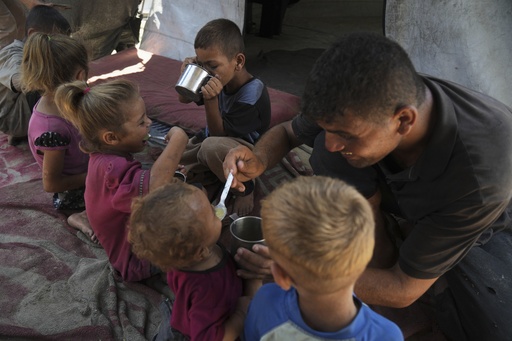In the heart of the Gaza Strip, Abeer and Fadi Sobh awaken each morning in their tattered tent with a daunting uncertainty: How will they provide food for themselves and their six children today? Their options are few and fraught with challenges. They might be fortunate enough to find an open charity kitchen dispensing watery lentils. Alternatively, they could face the perilous crowds for a chance at limited resources from aid trucks. Their last and most humbling option is to beg for sustenance. Increasingly, however, the family faces the harsh reality of going without food altogether, with hunger chipping away at their energy and hopes.
The Sobh family’s plight mirrors that of countless others throughout Gaza, where relentless conflict and stringent aid restrictions have rendered food scarce. Over the past 22 months of hostilities, these conditions have exacerbated starvation in the region. Experts caution that the situation in Gaza is deteriorating towards famine. Israel, in an effort to pressure Hamas, enforced a total blockade on food and other supplies for several months, impacting the daily lives of the territory’s residents. Though aid has resumed, it remains insufficient, and security issues make delivery difficult, leaving the sparse aid subject to exploitation and exorbitant prices.
Each morning, the Sobhs begin by battling the sweltering heat. Fresh water is scarce, so Abeer fetches seawater for the family’s daily routine. Her children take turns being bathed in salty water, a process harsh on nine-month-old Hala whose cries echo their daily hardship. After tidying the tent, Abeer sets out to find food, sometimes securing lentils from compassionate neighbors, sometimes finding nothing. If she’s fortunate, she’ll have something to mix with water for Hala’s bottle. “Every day feels eternal,” she laments.
Fadi seeks nourishment at a nearby soup kitchen, often returning empty-handed to a family growing accustomed to sleeping hungry. Formerly, he ventured to aid distribution sites, but the crowds were perilous and unpredictable. Once, he was shot and now his health, already afflicted by epilepsy, limits his pursuits to only meager local resources.
As the day progresses, Abeer and her children embark on the arduous trek to fill jerrycans with fresh water, a task made more burdensome by the heat and dust of the streets. The children, laden with the containers, soldier on, determined to support their family’s needs.
Occasionally, Abeer joins the throngs at aid distribution points, often coming away empty-handed but sometimes finding charity from those luckier. Grateful for any small mercy, she bakes whatever she secures for her children’s sustenance. As the sun intensifies, the family shelters themselves, conserving energy during the oppressive midday heat.
Afternoons bring more challenges as the children venture out again. At times, they must beg from neighbors, other times they scavenge through debris for fuel to cook with. The kids have become adept at identifying what can burn, although scraps are scarce. A discarded pot found amidst rubble has become an invaluable cooking vessel for the little food they manage to collect.
By evening, if fortune favors them, Abeer prepares a meal — typically a thin lentil soup. More often, there is nothing, and the family’s stomachs remain empty overnight. Abeer describes the fatigue and dizziness that accompanies her daily struggles, expressing a desperation exacerbated by the relentless conflict.
In the Gaza Strip, day by day, the Sobh family, like so many others, endures an existence marred by scarcity and hardship. Their resilience is tested, and with every passing day, hope wanes under the weight of an uncertain future.


